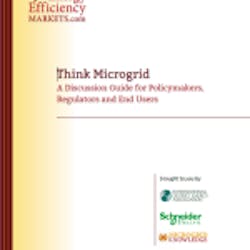So what is a microgrid, exactly?
The term has been used for years, yet those who attend microgrid conferences joke that much of the event is spent in debate over the definition. As is often the case with a popular technology, many would like to package their products as microgrids. Hence, we see the term’s meaning broadening in the marketplace.
This is the second article from our special report, Think Microgrid.
Let’s start with what a microgrid is not. Rob Thornton, president and CEO of the 105-year old International District Energy Association, often says that microgrids are “more than diesel generators with an extension cord.” In other words, a microgrid is not just back-up generation but should be a robust, 24/7/365 asset that provides primary energy services to a market A microgrid can provide back-up generation, but it offers additional, more intricate services as well.
For the purposes of this article series, and our report, “Think Microgrid: A Discussion Guide for Policymakers, Regulators and End Users,” we focused on advanced, grid-connected microgrids with the following characteristics.
- Produce onsite generation and optimally thermal energy to be economically competitive
- Serve a distinct, interconnected load, usually with multiple buildings or meters, within a defined geographical boundary or business district
- Can act as a single, controllable entity within the central grid
- Can operate in parallel to the grid, as a grid collaborator not competitor
- Can connect or disconnect (island) from the central grid during interruption events with black-start capability
- May participate in demand response, and buy power from the grid or sell energy, capacity and ancillary services to the grid, depending on economics/pricing
- Provide energy 24/7, 365 days a year
- Often incorporate advanced controls and communications and automation software for transparent and intelligent energy management and demand response
- Include distribution wires
- May use any form of fuel, but are likely to run on CHP/natural gas, fuel cells or solar energy, and sometimes wind power.
- May include thermal and electric storage
No set size exists for these microgrids; some generate power in the kilowatt range, while others produce more than 100 MW. Most existing microgrids in North America are customer-owned, although models are emerging for third-party ownership. A handful of utilities also are actively developing or operating microgrids. Some have rate-based microgrids, such as San Diego Gas & Electric, a model that is increasingly under discussion.
Several college campuses have operated microgrids in the United States for years. These are large and complex facilities that serve as models for the emerging era of the microgrid. The University of Texas at Austin, for example, operates a microgrid that provides 100 percent of the power, heating and cooling to 150 campus buildings encompassing 20 million square feet. It has done so for more than 40 years with 99.9998 percent reliability.
These campuses use combined heat and power and district energy, two tried-and-true technologies characterized by their high efficiency. CHP puts to good use the heat that is typically wasted in conventional power production. Rather than dumping waste heat to a nearby river, lake or ocean or simply letting the heat dissipate into the sky, a CHP plant reuses it for heating, cooling and steam production. District energy systems pipe water or steam from a central plant to heat or cool multiple buildings. This creates efficiency and cost savings because the buildings can forego installing individual boilers, chillers and air conditioners in each building. (See more details here on other ways CHP and district energy increase energy efficiency.)
“Having a microgrid allows you to marry the thermal side along with electrical and manage the whole thing together as a unit for your greatest benefit. That is really the power of microgrid.” – James Adams, director of utilities at Cornell University
Remote or mobile microgrids, too, are increasingly being adopted worldwide. Remote microgrids can be found on islands and isolated locations that are not connected to a grid. The US military uses mobile microgrids in places like Afghanistan where fuel transport is inherently dangerous and difficult. Some remote microgrids operate on fossil fuels, but increasingly they are incorporating wind power, solar energy, or other forms of renewable energy. By using energy storage, remote microgrids are able to accommodate the intermittency of renewable energy, a task that may be difficult for an energy facility that is not part of a larger, central grid.
But it is the grid-connected microgrid that is provoking the most discussion among US decision-makers, and is the focus of this article series. This type of energy facility could profoundly influence generation, distribution and transmission planning in the US. The microgrid also could become an increasingly important player in wholesale power markets, as we’ll discuss later in this series.
Come back next week for the third article in this series, or immediately download the full report, free of charge: Think Microgrid: A Discussion Guide for Policymakers, Regulators and End Users, courtesy of the report’s underwriters: the International District Energy Association, Schneider Electric and Microgrid Knowledge
About the Author
Elisa Wood
Editor-in-Chief
Elisa Wood is the editor and founder of EnergyChangemakers.com. She is co-founder and former editor of Microgrid Knowledge.
